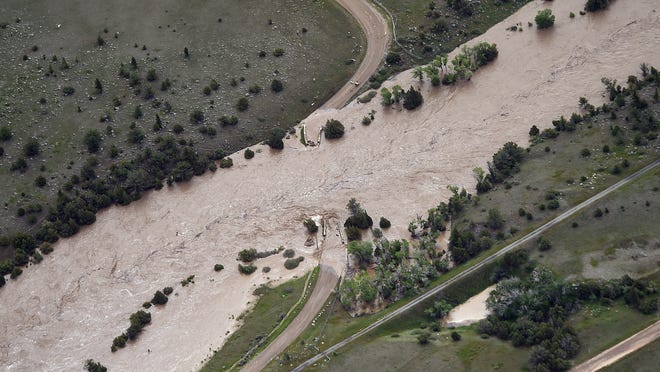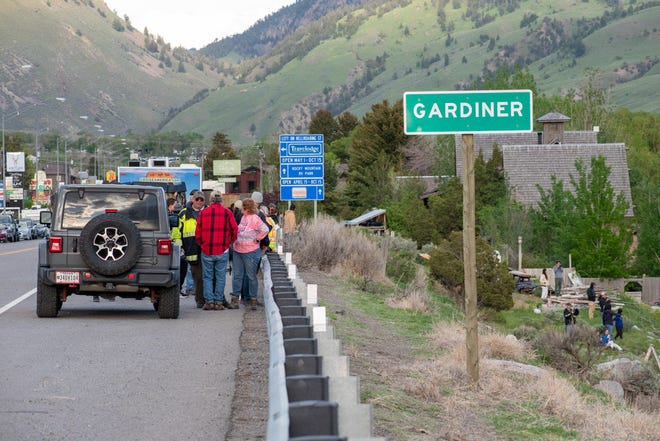GARDINER, Mont. – Yellowstone National Park officials assessed widespread damage Tuesday as the park remained closed amid dangerous floods, mudslides and rockslides that have eroded roads, ripped apart bridges and forced evacuations this week.
The water started to slowly recede Tuesday, but the record-level floods left all five entrances to the park closed through at least Wednesday, officials said.
The park has seen multiple road and bridge failures, power outages and mudslides, causing evacuations that started in the northern area of the park.
“I’ve never seen this, not in my lifetime,” said Austin King, a firefighter and EMT in Gardiner, a town just outside Yellowstone’s busy northern entrance.
There were no immediate reports of injuries, but floodwaters swept away a number of homes, bridges and other structures. The northern part of the park suffered the worst damage.
Montana Gov. Greg Gianforte declared a statewide disaster and said the Montana National Guard rescued 12 people stranded by high waters in Roscoe and Cooke City.
YELLOWSTONE CLOSED:Yellowstone National Park evacuates visitors
MORE:Home swept away as Yellowstone is hit by major floods and mudslides
Parker Manning, who is visiting from Terre Haute, Indiana, watched the flooding from a cabin in Gardiner. He said he saw trees and a mostly intact house floating in rushing waters.
The Yellowstone River reached highs of almost 14 feet on Monday, far higher than the record 11.5 feet set more than a century ago, according the the National Weather Service.
Yellowstone communities left stranded, without power
The flooding left Yellowstone’s small gateway communities in southern Montana isolated and without power, leading to evacuations by boat and helicopter.
With road access cut off, the only way in or out of Gardiner, a town of about 900 people, was by air.
“We’re on an island, so to speak,” said Marshall Haley, a campground manager near Gardiner. “Most of the motels were full, and the store’s going to run out of food pretty soon probably because no truck can get down here.”
A 10-person bunker was among the buildings that slipped from the riverbank into the water. Only a portion of the house’s foundation remained Tuesday.
“The community of Gardiner is currently isolated, and we are working with the county and state of Montana to provide necessary support to residents, who are currently without water and power in some areas,” Yellowstone officials said Monday.
Floodwaters also isolated Cooke City and Silvergate, which is east of the park, and led to evacuations in Livingston. As Stillwater River in south-central Montana flooded, 68 people were stranded at a campground as crews rescued campers by raft.
Officials in Park County, which encompasses those cities, issued shelter-in-place orders Monday and warned flooding had made drinking water unsafe in many communities. Residents hauled bottled water home from stores and worried about a possible food shortage. The county said water and air rescues were underway amid evacuations Monday.
“Extensive flooding throughout Park County has washed out bridges, roads, and left communities and homes isolated,” Park County said in a statement.
In the south-central Montana town of Joliet, Kristan Apodaca cried as she watched floodwaters overtake her grandmother’s log cabin and the park where her husband proposed.
“I am sixth-generation,” she told the Billings Gazette. “This is our home.”
King, the EMT in Gardiner, said the flooding was “damaging for a lot of people.”
“Some have lost their houses; others can’t go to work,” King said. “People are worried about food shortages already.”
YELLOWSTONE NEWS:National park renames mountain named for officer in Native American massacre
When will Yellowstone reopen?
Yellowstone officials have prohibited visitors from entering the park at any of its five entrances until at least Wednesday.
Cory Mottice, a National Weather Service meteorologist in Billings, Montana, said reduced rain and cooler temperatures, which could lead to decreased snowmelt, may lessen flooding.
Still, “this is flooding that we’ve just never seen in our lifetimes before,” Mottice said.
Why is Yellowstone flooding?
Record rainfall combined with rapidly melting snowpack caused the deluge of flooding this week. Scientists pointed to climate change as the culprit behind more intense and frequent weather events.
The floods come as the summer tourist season ramps up in June, one of the park’s busiest months.
‘This is serious’: Millions under heat wave warnings as triple-digit temps move east
What state is Yellowstone National Park in?
The world’s first national park, Yellowstone National Park encompasses nearly 3,500 square miles on top of a volcanic hot spot. The park lies mostly in Wyoming but spreads into Montana and Idaho.
The park allows visitors “to observe wildlife in an intact ecosystem, explore geothermal areas that contain about half the world’s active geysers, and view geologic wonders like the Grand Canyon of the Yellowstone River,” according to the Yellowstone’s website.
Contributing: The Associated Press
Contact News Now Reporter Christine Fernando at cfernando@usatoday.com or follow her on Twitter at @christinetfern.
Hannah Phillips of The Palm Beach Post reported from Gardiner, Montana.
YOU MAY LIKE:A first in Yellowstone, as man in Tesla proves his ‘ingenuity’



